SBOS153B September 2000 – January 2016 OPA541
PRODUCTION DATA.
- 1 Features
- 2 Applications
- 3 Description
- 4 Revision History
- 5 Pin Configuration and Functions
- 6 Specifications
- 7 Detailed Description
- 8 Application and Implementation
- 9 Power Supply Recommendations
- 10Layout
- 11Device and Documentation Support
- 12Mechanical, Packaging, and Orderable Information
8 Application and Implementation
NOTE
Information in the following applications sections is not part of the TI component specification, and TI does not warrant its accuracy or completeness. TI’s customers are responsible for determining suitability of components for their purposes. Customers should validate and test their design implementation to confirm system functionality.
8.1 Application Information
The OPA541 is specified for operation from 8 V to 80 V (±4 V to ±40 V). Specifications apply over the –40°C to 85°C temperature range while the device operates from –40°C to 125°C. Parameters that can exhibit significant variance with regard to operating voltage or temperature are presented in Typical Characteristics.
8.1.1 Current Limit
Internal current limit circuitry is controlled by a single external resistor, RCL. Output load current flows through this external resistor. The current limit is activated when the voltage across this resistor is approximately a base-emitter turnon voltage. The value of the current limit resistor is calculated by Equation 1.
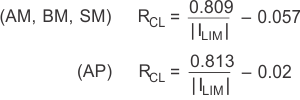
Because of the internal structure of the OPA541, the actual current limit depends on whether current is positive or negative. The above RCL gives an average value. For a given RCL, +IOUT will actually be limited at approximately 10% below the expected level, while –IOUT will be limited approximately 10% above the expected level.
The current limit value decreases with increasing temperature due to the temperature coefficient of a base-emitter junction voltage. Similarly, the current limit value increases at low temperatures. Current limit versus resistor value and temperature effects are shown in Typical Characteristics. Approximate values for RCL at other temperatures may be calculated by adjusting RCL shown in Equation 2.

The adjustable current limit can be set to provide protection from short circuits. The safe short-circuit current depends on power supply voltage. See the discussion on safe operating area in Safe Operating Area to determine the proper current limit value.
Because the full load current flows through RCL, it must be selected for sufficient power dissipation. For a 5-A current limit on the TO-3 package, the formula yields an RCL of 0.105 Ω (0.143 Ω on the power plastic package due to different internal resistances). A continuous 5 A through 0.105 Ω would require an RCL that can dissipate 2.625 W.
Sinusoidal outputs create dissipation according to RMS load current. For the same RCL, AC peaks would still be limited to 5 A, but RMS current would be 3.5 A, and a current-limiting resistor with a lower power rating could be used. Some applications (such as voice amplification) are assured of signals with much lower duty cycles, allowing a current resistor with a low power rating. Wire-wound resistors may be used for RCL. Some wire-wound resistors, however, have excessive inductance and may cause loop-stability problems. Evaluate circuit performance with the resistor type planned for production to assure proper circuit operation.
8.1.2 Heat Sinking
Power amplifiers are rated by case temperature, not ambient temperature as with signal operational amplifiers. Sufficient heat sinking must be provided to keep the case temperature within rated limits for the maximum ambient temperature and power dissipation. The thermal resistance of the heat sink required may be calculated by Equation 3.

Commercially available heat sinks often specify their thermal resistance. These ratings are often suspect, however, because they depend greatly on the mounting environment and air flow conditions. Actual thermal performance should be verified by measuring the case temperature under the required load and environmental conditions.
No insulating hardware is required when using the TO-3 package. Because mica and other similar insulators typically add approximately 0.7°C/W thermal resistance, their elimination significantly improves thermal performance. See Related Documentation for further details on heat sinking. On the power plastic package, the metal tab may have a high or low impedance connection to –VS. The case must be allowed to float, and likely assumes the potential of –VS. Current must not be conducted through the case.
8.1.3 Safe Operating Area
The safe operating area (SOA) plot provides comprehensive information on the power-handling abilities of the OPA541. The SOA shows the allowable output current as a function of the voltage across the conducting output transistor (see Figure 11). This voltage is equal to the power supply voltage minus the output voltage. For example, as the amplifier output swings near the positive power supply voltage, the voltage across the output transistor decreases and the device can safely provide large output currents demanded by the load. Short circuit protection requires evaluation of the SOA. When the amplifier output is shorted to ground, the full power supply voltage is impressed across the conducting output transistor. The current limit must be set to a value which is safe for the power supply voltage used. For instance, with VS ±35 V, a short to ground would force 35 V across the conducting power transistor. A current limit of 1.8 A would be safe.
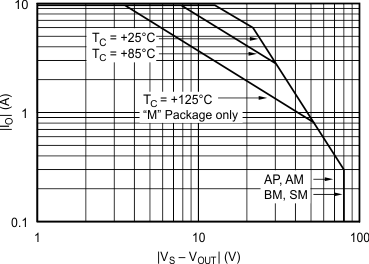 Figure 11. Safe Operating Area
Figure 11. Safe Operating Area
Reactive or EMF-generating loads such as DC motors can present difficult SOA requirements. With a purely reactive load, output voltage and load current are 90° out of phase. Thus, peak output current occurs when the output voltage is zero and the voltage across the conducting transistor is equal to the full power supply voltage. See Related Documentation for further information on evaluating SOA.
8.1.4 Replacing Hybrid Power Amplifiers
The OPA541 can be used in applications currently using various hybrid power amplifiers, including the OPA501, OPA511, OPA512, and 3573. Of course, the application must be evaluated to assure that the output capability and other performance attributes of the OPA541 meet the necessary requirements. These hybrid power amplifiers use two current limit resistors to independently set the positive and negative current limit value. Because the OPA541 uses only one current limit resistor to set both the positive and negative current limit, only one resistor such as Figure 12 need be installed. If installed, the resistor connected to pin 2 (TO-3 package) is superfluous, but is does no harm.
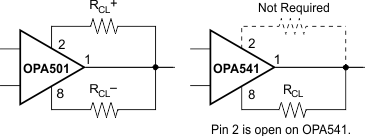 Figure 12. Isolating Capacitive Loads
Figure 12. Isolating Capacitive Loads
Because one resistor carries the current previously carried by two, the resistor may require a high power rating. Minor adjustments may be required in the resistor value to achieve the same current limit value. Often, however, the change in current limit value when changing models is small compared to its variation over temperature. Many applications can use the same current limit resistor.
8.2 Typical Applications
8.2.1 Clamping Output for EMF-Generating Loads
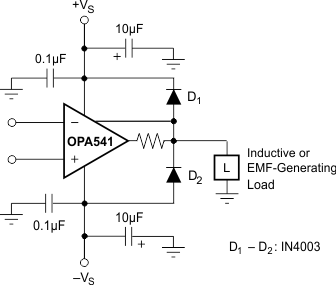 Figure 13. Clamping Output for EMF-Generating Loads
Figure 13. Clamping Output for EMF-Generating Loads
8.2.1.1 Design Requirements
- Motor drive with reversal requiring output clamping
- 20-V motor
- 1-Ω DC resistance
- 10-µH inductance
- 40°C maximum ambient temperature
8.2.1.2 Detailed Design Procedure
8.2.1.2.1 Power Supply Requirements
Select the power supply based on the requirement to achieve a ±20-V output with up to a 5-A load. The maximum value for output voltage swing at 5-A is approximately within 4 V of either rail and ±25. These supplies provide sufficient output swing.
8.2.1.2.2 Current Limit and SOA (Safe Operating Area)
Set the current limit to the highest possible value for the application which generally corresponds to a short circuit on the output. In this application this corresponds to 25-V stress on the output device and examination of the SOA (Safe Operating Area) graph in Figure 11 indicates that a 5-A current limit is within the 25°C SOA.
8.2.1.2.3 Heat Sinking
Short circuit conditions at 5 A and 25 V must support 125 W of dissipation up to the 40°C ambient requirements of the application. This indicates the need for a heatsink with a RθHA < 0.68°C/W, such as an Waekfield-Vette 345 series.
8.2.1.3 Application Curve
The scope trace in Figure 14 depicts a motor reversal of a 20-V motor being driven by an OPA541 powered by ±25 V. This motor has 1 Ω of DC resistance and 10 µH of inductance.
NOTE
At the beginning of the reversal the motor inductance results in an overshoot up to the supply rail. This overshoot is clamped by the external fast recovery diodes. While the current shown exceeds the 5-A current limit, this current is actually flowing in the flyback diodes.
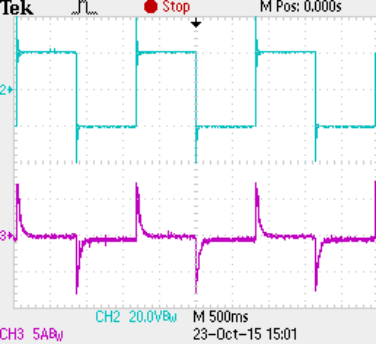 Figure 14. Transient Response
Figure 14. Transient Response
8.2.2 Paralleled Operation, Extended SOA
Parallel operation is often used to increase output current or wattage. However, due to their low output impedance, power operational amplifiers cannot be connected in parallel without modifying the circuits. Figure 15 shows one method of doing this. The upper amplifier is a master, configured as required to satisfy the circuit function, has a small sense resistor inside its feedback loop. The slave amplifier is a unity gain buffer. Thus, the output voltages of the two amplifiers are equal. If the two sense resistors connected to the load are equal, the amplifiers share current equally. More slaves may be added as desired. The additional resistor and capacitor on the slave enhance stability.
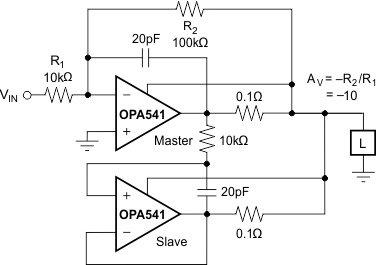 Figure 15. Paralleled Operation, Extended SOA
Figure 15. Paralleled Operation, Extended SOA
8.2.2.1 Design Requirements
Design requirements for the parallel connection in Figure 15 are shown here. The maximum current available from a single OPA541 cannot exceed 10 A:
- Gain from input to output of –10
- Current capability of > 15 A
- Short to ground on ±15-V supply rails at 25°C case temperature
8.2.3 Programmable Voltage Source
The programmable voltage source of Figure 16 uses the OPA541 as a current-to-voltage converter for a current output DAC (digital-to-analog converter). The diodes clamp any differential input voltages to safe levels for the OPA541. The OPA541 provides the gain to produce the desired output.
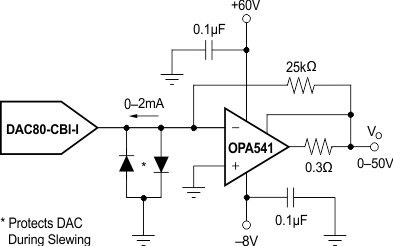 Figure 16. Programmable Voltage Source
Figure 16. Programmable Voltage Source
8.2.3.1 Design Requirements
Design requirements for Figure 16:
- Convert 0 to –2-mA current input to 0-V to 50-V output voltage
- Current capability of > 2.5 A
- Protection of current output DAC during fast slew
8.2.4 16-Bit Programmable Voltage Source
The 16-bit voltage source achieves its precision by using an OPA27 along with precision resistors in a feedback path that provides high overall accuracy.
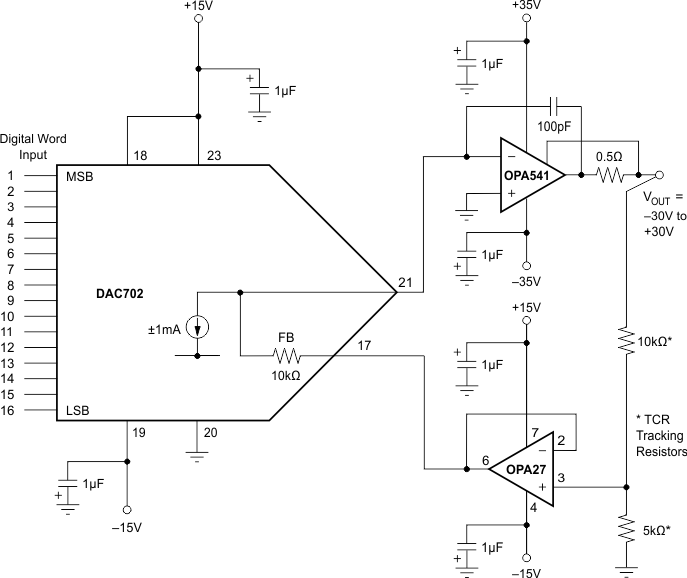 Figure 17. 16-Bit Programmable Voltage Source
Figure 17. 16-Bit Programmable Voltage Source
8.2.4.1 Design Requirements
Design requirements for the programmable voltage source shown in Figure 17:
- ±30-V output programmable to 16-bit resolution
- > ±1.5-A current capability
- < 500-μV offset at zero output
- linearity error less than ±0.0015%
- differential linearity error less than ±0.003%